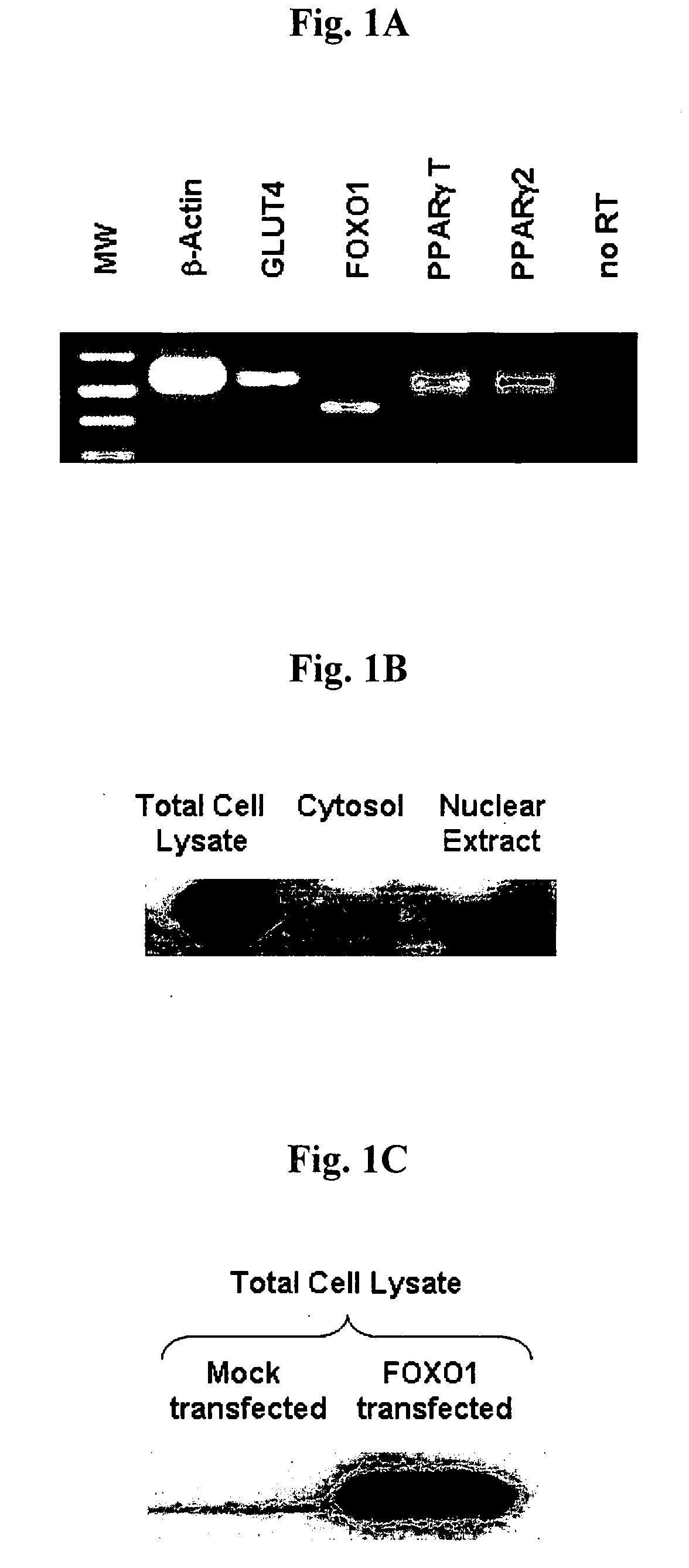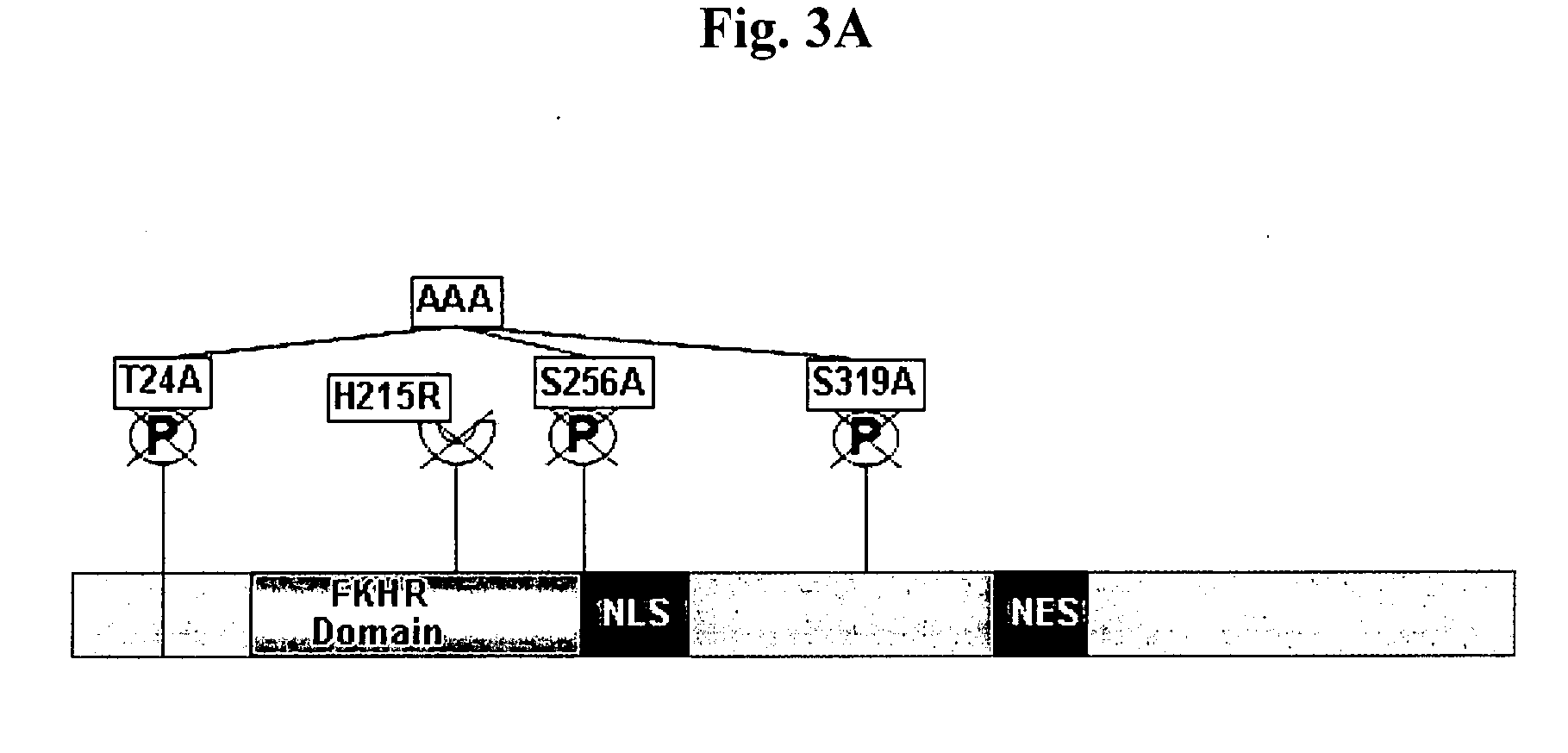Modulation of PPARgamma2 gene promoter by FOXO1
a technology of foxo1 and promoter, which is applied in the field of foxo1mediated ppar gene promoter regulation, can solve the problems of not fully known, largely unknown mechanisms regulating the ppar gene promoter itself, and unfavorable ppar gene transcription
- Summary
- Abstract
- Description
- Claims
- Application Information
AI Technical Summary
Benefits of technology
Problems solved by technology
Method used
Image
Examples
example 1
Endogenous Gene Expression
[0057]Endogenous gene expression at mRNA and protein level was examined by RT-PCR and Western blot analyses, respectively. As shown in FIG. 1A, isolated primary rat adipocytes showed endogenous expression of mRNA for GLUT4, FOXO1, total PPARγ and PPARγ2. Endogenous expression of GLUT4 was taken as a marker for an insulin-responsive tissue. Western immunoblotting showed endogenous expression of FOXO1 protein in total cell lysates prepared from primary rat adipocytes; under these basal conditions, FOXO1 was localized to the nuclear fraction and undetected in the cytosol (FIG. 1B). We also determined the expression efficiency of FOXO1 in primary rat adipocytes by Western immunoblotting, and found that exogenous FOXO1 is over-expressed to 20-fold of the endogenous protein (FIG. 1C).
example 2
Transcriptional Activity of PPARγ1 and PPARγ2 is Differentially Regulated by FOXO1 and Insulin
[0058]Once establishing the expression patterns of endogenous and exogenous FOXO1 in primary rat adipocytes, we next studied the effects of FOXO1 on human PPARγ1 and PPARγ2 gene expression at transcriptional level. PRA were co-transfected with luciferase-conjugated promoter reporters for either the human PPARγ1 or PPARγ2, (PPARγ1-P and PPARγ2-P, respectively) along with expression vector for wild type FOXO1 (FIGS. 2A-2B). We found that expression of wild type FOXO1 repressed the transcriptional activity of both the co-expressed PPARγ1-P and PPARγ2-P in a dose-dependent manner, to as much as 65% below basal levels. Incubation of cells with 100 nM insulin resulted in a dose-dependent reversal of FOXO1 effects on the PPARγ1 promoter, with transcriptional activity reaching 102±3% of basal level at maximal FOXO1 dose applied. Insulin also interfered with FOXO1 repression of the PPARγ2 promoter, ...
example 3
Differential Contribution of FOXO1 Domains to PPARγ Promoter Regulation
[0059]The differential contribution of the various functional domains of FOXO1 to PPARγ-P repression was studied under basal as well as insulin-mediated conditions using constructs that are point-mutated as schematically depicted in FIG. 3A. The contribution of each of the three PKB / Akt phosphorylation sites of FOXO1 was studied using non-phosphorylatable mutants of FOXQ1, T24A, S256A, S319A, and a triple mutant, AAA, in which all three phosphorylation sites were mutated to alanine. Cells were co-transfected with PPARγ promoter reporters along with the various FOXO1 mutants, and incubated either at basal conditions or with 100 mM insulin for 24 hrs. We found that mutations in each of the sites did not affect the basal capacity of FOXO1 to repress the PPARγ1 promoter, as revealed by similar basal promoter activity of the mutated proteins and the wild type protein (white bars, while significantly reducing insulin's...
PUM
| Property | Measurement | Unit |
|---|---|---|
| molecular weight | aaaaa | aaaaa |
| pH | aaaaa | aaaaa |
| volume | aaaaa | aaaaa |
Abstract
Description
Claims
Application Information
 Login to View More
Login to View More - R&D
- Intellectual Property
- Life Sciences
- Materials
- Tech Scout
- Unparalleled Data Quality
- Higher Quality Content
- 60% Fewer Hallucinations
Browse by: Latest US Patents, China's latest patents, Technical Efficacy Thesaurus, Application Domain, Technology Topic, Popular Technical Reports.
© 2025 PatSnap. All rights reserved.Legal|Privacy policy|Modern Slavery Act Transparency Statement|Sitemap|About US| Contact US: help@patsnap.com



